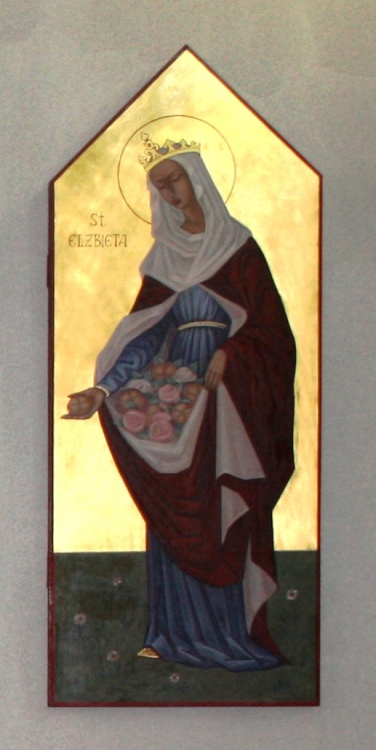We help
We ask you for help
For volunteers
Reports
Dear friends,
The 17th November is the feast day of Saint Elizabeth of Hungary, who is world-wide known as the international patron of Caritas. Her vocation was to care for the sick and homeless.
 Elizabeth was the daughter of King Andrew II of Hungary and was born in 1207. At the age of four, Elizabeth was brought to the court of the rulers of Thuringia in central Germany, to become betrothed to Louis IV, Landgrave of Thuringia. She was raised by the Thuringian court to become a future bride. At the age of fourteen, Elizabeth married Louis. The young couple lived in love and harmony.
Elizabeth was the daughter of King Andrew II of Hungary and was born in 1207. At the age of four, Elizabeth was brought to the court of the rulers of Thuringia in central Germany, to become betrothed to Louis IV, Landgrave of Thuringia. She was raised by the Thuringian court to become a future bride. At the age of fourteen, Elizabeth married Louis. The young couple lived in love and harmony.
Elizabeth was a very devout person, as evidenced not only by many hours of daily prayer, but also her charity. She donated not only a part of her wealth, but also personally ministered to the ill and poor: she dedicated herself to care for the sick, cooked food for them and sewed clothes. Her husband fully shared the views of Elizabeth and supported her.
On the icons, St. Elizabeth is depicted as a young woman carrying bread and roses in her apron.
Whilst she was taking bread to the poor in secret, she met her brother in law, Heinrich Raspe, who questioned her to reveal what was hidden under her cloak, as she was suspicioned to be stealing treasures from the castle. In that moment, her cloak fell open and a vision of white and red roses could be seen.
Another legend relates how she laid a leper in the bed she shared with her husband. When Ludwig removed the bedclothes in great indignation, at that instant instead of a leper he saw the figure of Christ crucified stretched upon the bed.
As once after a flood, famine and plague wrought havoc in Thuringia, Elizabeth ordered to open the landgrave granaries to feed the starving population, even giving away state robes and ornaments to the poor. She daily fed more than 900 people. She built two hospitals to the poor and visited the inmates to attend to them.
When Elizabeth was 20 years old, Louis joined a crusade and died of a plague. On hearing the news of her husband's death, Elizabeth is reported to have said, "He is dead. He is dead. It is to me as if the whole world died today."
The Ludwig's relatives, who used to behave malevolently against her, used his death to withdraw all political influence from the young widow and to acquire all of her possessions, including the dowry which she had brought to her husband.
The priest Konrad von Marburg was appointed as confessor and spiritual director of Elisabeth. Following her husband's death, Elizabeth made solemn vows to Konrad similar to those of a nun. These vows included celibacy, as well as complete obedience to Konrad. Konrad's treatment of Elizabeth was extremely harsh, and he held her to standards of behavior which were almost impossible to meet. E.g. he ordered her to send away her three children.
It is unknown if she left the court at Wartburg of her own free will because of the conflict with the relatives of her deceased husband or she was cast out. She left the court with her youngest daughter, Gertrude, who was born after her father's death, and found a shelter at her uncle, the Bishop of Bamberg.
After bitter arguments over the disposal of her dowry, the interests of her three children, born of the happy, but short marriage between Elizabeth and Louis of Thuringia, were protected. The rest of her short life Elizabeth completely devoted to the Lord.
At the age of 21, on a Good Friday she made with her three faithful handmaidens a renewed vow to live according to the apostolic ideal. She was not distracted any more by the duties of a court lady and could devote herself fully to her service and prayer.
As before, she ministered to the sick, sewed clothes for the poor, and made handicrafts.
She earned the livelihood of her small community by spinning of wool for the gray habits of the Franciscan friars. She then built a hospital at Marburg (her 3rd hospital) for the poor and the sick with the money from her dowry, where she and her companions cared for them. She cooked food for the patients and cleaned the floor.
Her former handmaidens and now sisters in Christ saw her overworked and tried to persuade her to have at least a short rest, because they were worried about her health. However, she continued to work as if she hastened to give the sick and abandoned as much love and care as she could, before her time would come to go to heaven.
Elizabeth of Hungary, the widowed Countess of Thuringia, died in Marburg on 17th November 1231 at the age of twenty-four. Dressed in the gray habit, which she used to wear in her life, she was buried in the chapel of the hospital, which was founded by her.
Very soon after the death of Elizabeth, many miracles were reported that happened at her grave in the church of the hospital or through the invocation of Elizabeth of Hungary, especially those of healing. Her canonization was very quick; she was declared a saint already in 1235.